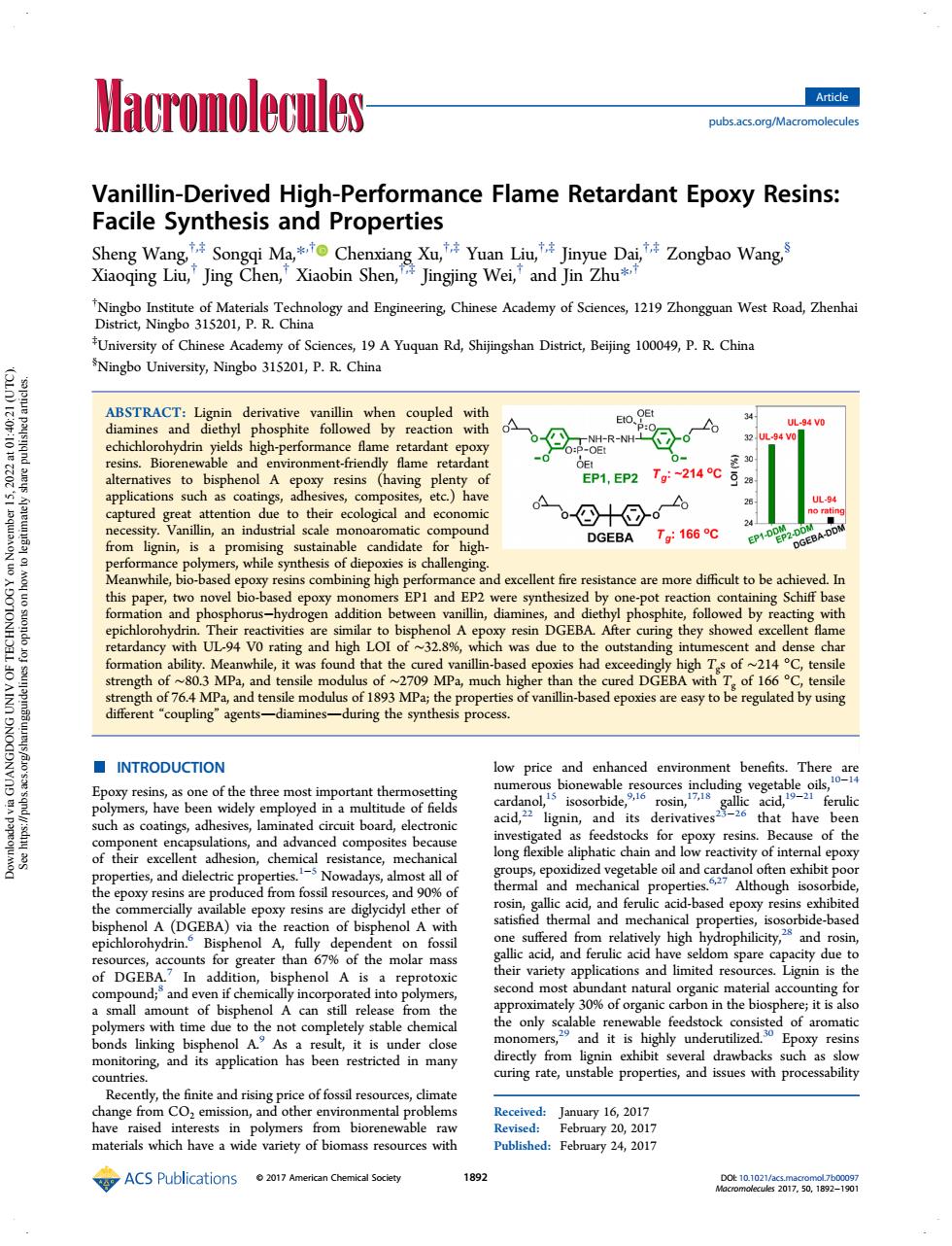正在加载图片...

Macromolecules Article Vanillin-Derived High-Performance Flame Retardant Epoxy Resins: Facile Synthesis and Properties Sheng Wang Songqi Ma,Chenxiang Xu,Yuan Liu,Jinyue Dai,Zongbao Wang, Xiaoqing Liu,?Jing Chen,"Xiaobin Shen,Jingjing Wei,and Jin Zhu* of Ch 19A Yuquan Rd,Shijingshan District,Beijing 100049,P.R China ingbo iversity,Ningbo 315201,P.R China UL-94 VO etardant o- EP1,EP2Tg-214 applications 04 DGEBA Tr166℃ ies is challe stance are more diffi ult to be ac pape orus-hyd ogen ad dition I by re ing RA A wit dancy with UL4 Vo rating and high LOI of32 which ue to the utstandin dens cha dD2BAoStem ex 76.4 and ter vanillin-based epoxies are easy to be regulated by using INTRODUCTION 。arg and its d that have 30 esives,I ted circuit boa cks to d epory resin of the their exce adhesi d90 able o and cadan he epoxy resins are proid-based prop nol fully dep fossi ted into tely stable che prope ry16,2017 materials which have a wide of biomass Publi-hed。Fcbruay24201 189 C 0202090 Vanillin-Derived High-Performance Flame Retardant Epoxy Resins: Facile Synthesis and Properties Sheng Wang,†,‡ Songqi Ma,*,† Chenxiang Xu,†,‡ Yuan Liu,†,‡ Jinyue Dai,†,‡ Zongbao Wang,§ Xiaoqing Liu,† Jing Chen,† Xiaobin Shen,†,‡ Jingjing Wei,† and Jin Zhu*,† † Ningbo Institute of Materials Technology and Engineering, Chinese Academy of Sciences, 1219 Zhongguan West Road, Zhenhai District, Ningbo 315201, P. R. China ‡ University of Chinese Academy of Sciences, 19 A Yuquan Rd, Shijingshan District, Beijing 100049, P. R. China § Ningbo University, Ningbo 315201, P. R. China ABSTRACT: Lignin derivative vanillin when coupled with diamines and diethyl phosphite followed by reaction with echichlorohydrin yields high-performance flame retardant epoxy resins. Biorenewable and environment-friendly flame retardant alternatives to bisphenol A epoxy resins (having plenty of applications such as coatings, adhesives, composites, etc.) have captured great attention due to their ecological and economic necessity. Vanillin, an industrial scale monoaromatic compound from lignin, is a promising sustainable candidate for highperformance polymers, while synthesis of diepoxies is challenging. Meanwhile, bio-based epoxy resins combining high performance and excellent fire resistance are more difficult to be achieved. In this paper, two novel bio-based epoxy monomers EP1 and EP2 were synthesized by one-pot reaction containing Schiff base formation and phosphorus−hydrogen addition between vanillin, diamines, and diethyl phosphite, followed by reacting with epichlorohydrin. Their reactivities are similar to bisphenol A epoxy resin DGEBA. After curing they showed excellent flame retardancy with UL-94 V0 rating and high LOI of ∼32.8%, which was due to the outstanding intumescent and dense char formation ability. Meanwhile, it was found that the cured vanillin-based epoxies had exceedingly high Tgs of ∼214 °C, tensile strength of ∼80.3 MPa, and tensile modulus of ∼2709 MPa, much higher than the cured DGEBA with Tg of 166 °C, tensile strength of 76.4 MPa, and tensile modulus of 1893 MPa; the properties of vanillin-based epoxies are easy to be regulated by using different “coupling” agentsdiaminesduring the synthesis process. ■ INTRODUCTION Epoxy resins, as one of the three most important thermosetting polymers, have been widely employed in a multitude of fields such as coatings, adhesives, laminated circuit board, electronic component encapsulations, and advanced composites because of their excellent adhesion, chemical resistance, mechanical properties, and dielectric properties.1−5 Nowadays, almost all of the epoxy resins are produced from fossil resources, and 90% of the commercially available epoxy resins are diglycidyl ether of bisphenol A (DGEBA) via the reaction of bisphenol A with epichlorohydrin.6 Bisphenol A, fully dependent on fossil resources, accounts for greater than 67% of the molar mass of DGEBA.7 In addition, bisphenol A is a reprotoxic compound;8 and even if chemically incorporated into polymers, a small amount of bisphenol A can still release from the polymers with time due to the not completely stable chemical bonds linking bisphenol A.9 As a result, it is under close monitoring, and its application has been restricted in many countries. Recently, the finite and rising price of fossil resources, climate change from CO2 emission, and other environmental problems have raised interests in polymers from biorenewable raw materials which have a wide variety of biomass resources with low price and enhanced environment benefits. There are numerous bionewable resources including vegetable oils,10−14 cardanol,15 isosorbide,9,16 rosin,17,18 gallic acid,19−21 ferulic acid,22 lignin, and its derivatives23−26 that have been investigated as feedstocks for epoxy resins. Because of the long flexible aliphatic chain and low reactivity of internal epoxy groups, epoxidized vegetable oil and cardanol often exhibit poor thermal and mechanical properties.6,27 Although isosorbide, rosin, gallic acid, and ferulic acid-based epoxy resins exhibited satisfied thermal and mechanical properties, isosorbide-based one suffered from relatively high hydrophilicity,28 and rosin, gallic acid, and ferulic acid have seldom spare capacity due to their variety applications and limited resources. Lignin is the second most abundant natural organic material accounting for approximately 30% of organic carbon in the biosphere; it is also the only scalable renewable feedstock consisted of aromatic monomers,29 and it is highly underutilized.30 Epoxy resins directly from lignin exhibit several drawbacks such as slow curing rate, unstable properties, and issues with processability Received: January 16, 2017 Revised: February 20, 2017 Published: February 24, 2017 Article pubs.acs.org/Macromolecules © 2017 American Chemical Society 1892 DOI: 10.1021/acs.macromol.7b00097 Macromolecules 2017, 50, 1892−1901 Downloaded via GUANGDONG UNIV OF TECHNOLOGY on November 15, 2022 at 01:40:21 (UTC). See https://pubs.acs.org/sharingguidelines for options on how to legitimately share published articles